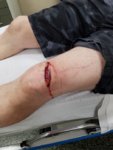- Banned
- #41
And this is why i always advice hunter to acquire some medical skills. i brother son broke his ankle while hunting, fortunately my brother knows a thing or thing about chiropractor. he could set the ankle back before heading to the hospital. the ankle would have swollen if he didn't know what to do. i always take a first-Aid kit to a hunt, safety is priority.



